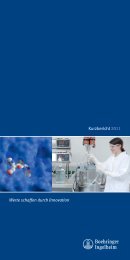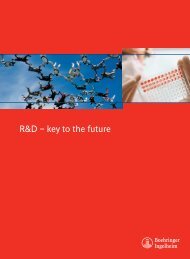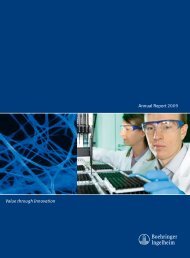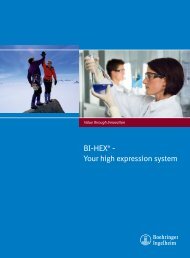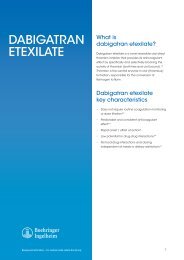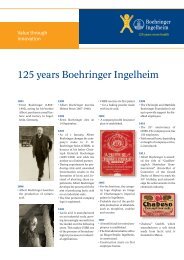Annual Report 2006 - Boehringer Ingelheim
Annual Report 2006 - Boehringer Ingelheim
Annual Report 2006 - Boehringer Ingelheim
You also want an ePaper? Increase the reach of your titles
YUMPU automatically turns print PDFs into web optimized ePapers that Google loves.
Our R & D for respiratory diseases<br />
Our worldwide launch of spiriva® (tiotropium)<br />
provided a medication to improve COPD therapy<br />
and strengthened our leading position in this field.<br />
We are striving for further innovations by devel-<br />
oping bronchodilators with alternative mecha-<br />
nisms. These new bronchodilators are being for-<br />
mulated in innovative inhalation devices.<br />
In addition, <strong>Boehringer</strong> <strong>Ingelheim</strong> in <strong>2006</strong> entered<br />
into a worldwide collaboration, development and<br />
licence agreement with the British company<br />
Vectura. The aim of the collaboration is to develop<br />
a multi-dose dry powder inhaler as a <strong>Boehringer</strong><br />
<strong>Ingelheim</strong> branded device, to deliver a range of<br />
proprietary <strong>Boehringer</strong> <strong>Ingelheim</strong> respiratory<br />
products, mainly for the treatment of COPD and<br />
asthma. We currently have numerous bronchodilator<br />
programmes in development, six of them<br />
in clinical studies.<br />
Extending our product portfolio to drugs that<br />
target treatment of the underlying inflammation<br />
and the tissue remodelling process are further key<br />
goals in our COPD research. Inflammation in<br />
COPD patients is provoked by an infiltration of<br />
the lungs by macrophages and neutrophils.<br />
This is only poorly controlled by current, widelyused<br />
anti-inflammatory drugs, such as corticosteroids.<br />
We are therefore working on alternative<br />
anti-inflammatory mechanisms, specifically targeting<br />
macrophage and neutrophil-driven inflammation.<br />
In addition, we aim at preventing or delaying tissue<br />
remodelling that is induced by chronic inflammation<br />
by targeting lung growth factors. Two<br />
first-in-class mechanisms targeting mucous<br />
hyperplasia and fibrosis are being tested clinically.<br />
Beyond COPD, such new mechanisms have a<br />
therapeutic potential in idiopathic pulmonary<br />
fibrosis (IPF), a life-threatening disease, and in<br />
<strong>Boehringer</strong> <strong>Ingelheim</strong> A n n u A l R e p o R t 2 0 0 6<br />
severe asthma, where mucous plugging is considered<br />
the main cause of death.<br />
Our research in asthma is aimed at new mechanisms<br />
and immunological paradigms that would<br />
allow us to replace or reduce the doses of inhaled<br />
steroids by providing anti-inflammatory therapy<br />
better tolerated by patients. Another goal is to<br />
provide a new treatment for specific syndromes<br />
with high, unmet medical need, such as severe,<br />
steroid-resistant asthma.<br />
Diseases of the<br />
central nervous system<br />
According to World Health Organization (WHO)<br />
predictions, diseases of the central nervous system<br />
will constitute an increasing medical need in this<br />
century, attributable to an exponential increase of<br />
these diseases in patients beyond 65 years of age,<br />
combined with an aging population. To date,<br />
available therapeutic treatments are still unsatisfactory<br />
for the majority of CNS diseases.



